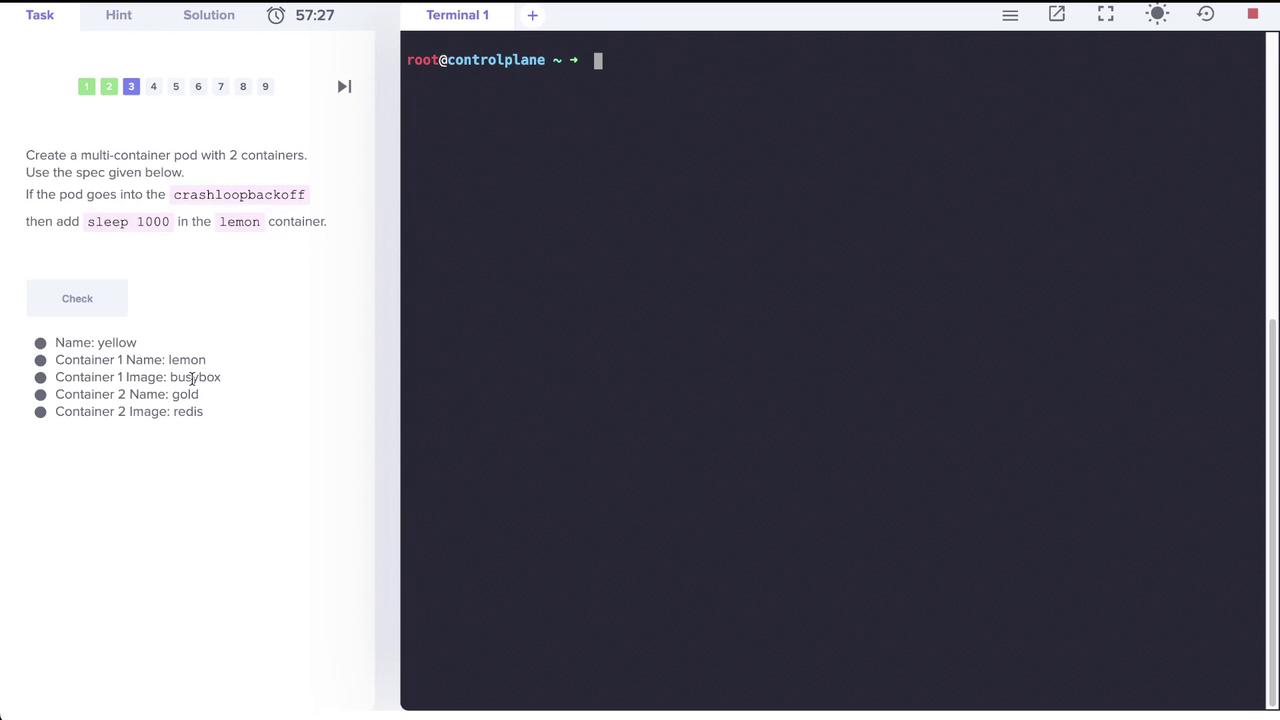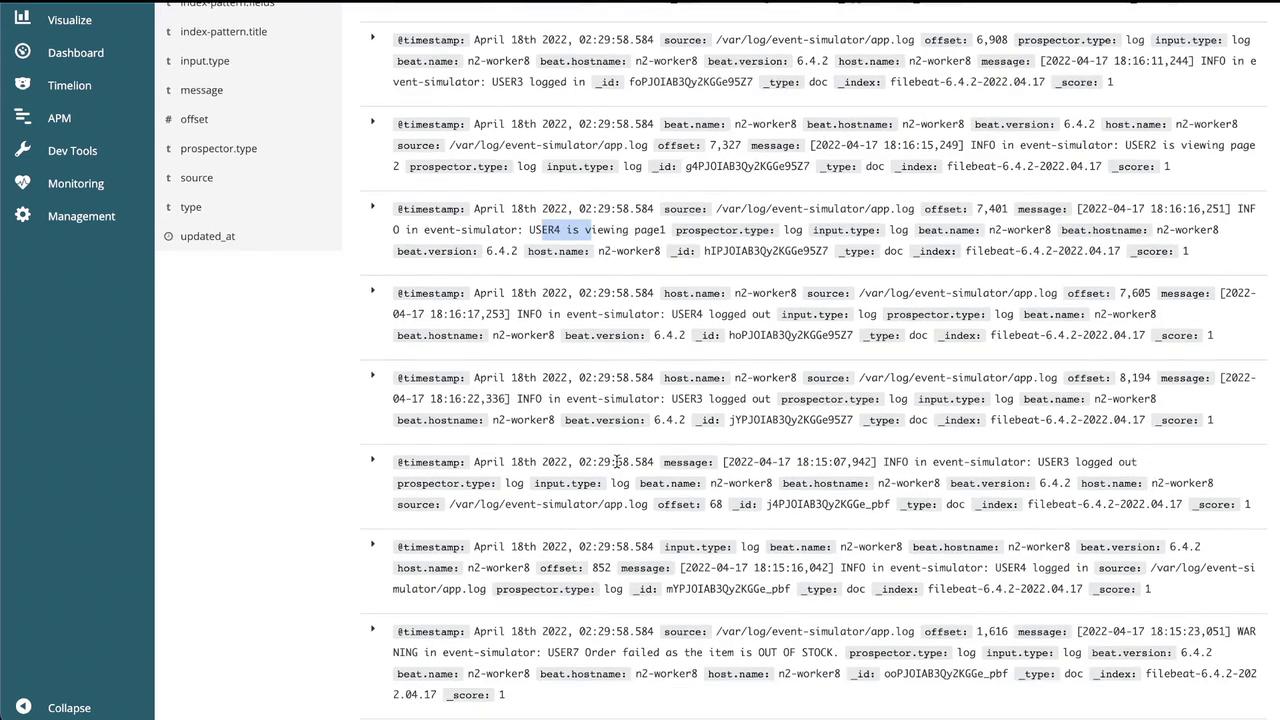Certified Kubernetes Application Developer - CKAD
Multi Container Pods
Solution Multi Container Pods Optional
In this article, we review a lab exercise on multi-container pods. The lab demonstrates how to identify container counts in pods, create multi-container pods using specified images, and add a sidecar container to forward logs to Elasticsearch. This step-by-step guide will help you understand these concepts and implement them in your Kubernetes environment.
Identifying Containers in the Red Pod
To determine the number of containers in the red pod, you have two options:
- Check the "READY" column in the pod listing—the numbers indicate total containers versus how many are ready.
- Use the
describecommand to inspect the pod details. In the output, look for the "Containers:" section. For example, the following YAML snippet shows three container entries namedapple,wine, andsearle:
Containers:
apple:
Container ID: busybox
Image: <none>
Image ID: <none>
Port:
Host Port: <none>
Command:
sleep
4500
State: Waiting
Reason: ContainerCreating
Ready: False
Restart Count: 0
Environment: <none>
Mounts:
/var/run/secrets/kubernetes.io/serviceaccount from kube-api-access-7sggv (ro)
wine:
Container ID: busybox
Image: <none>
Image ID: <none>
Port:
Host Port: <none>
Command:
sleep
4500
State: Waiting
Reason: ContainerCreating
Ready: False
Restart Count: 0
Environment: <none>
Mounts:
/var/run/secrets/kubernetes.io/serviceaccount from kube-api-access-7sggv (ro)
searle:
Container ID: busybox
Image: <none>
Image ID: <none>
Port:
Host Port: <none>
Command:
<none>
Both methods confirm that the red pod contains three containers.
Identifying Containers in the Blue Pod
Next, determine the container names in the blue pod. Examining its details reveals two containers, named teal and navy. Below is an excerpt of the pod details:
Node: controlplane/10.40.119.6
Start Time: Sun, 17 Apr 2022 18:16:47 +0000
Labels: <none>
Annotations: <none>
Status: Pending
IP: <none>
IPs: <none>
Containers:
teal:
Container ID:
Image: busybox
Image ID: <none>
Port: <none>
Host Port: <none>
Command:
- sleep
- '4500'
State: Waiting
Reason: ContainerCreating
Ready: False
Restart Count: 0
Environment: <none>
Mounts: /var/run/secrets/kubernetes.io/serviceaccount from kube-api-access-6qm72 (ro)
navy:
Container ID:
Image: busybox
Image ID: <none>
Port: <none>
Host Port: <none>
Command:
- sleep
- '4500'
State: Waiting
Reason: ContainerCreating
Ready: False
Restart Count: 0
Environment: <none>
Mounts: /var/run/secrets/kubernetes.io/serviceaccount from kube-api-access-6qm72 (ro)
This confirms that the blue pod runs two containers: teal and navy.
Creating a Multi-Container Pod (Yellow Pod)
The next task is to create a multi-container pod named yellow that includes two containers. Follow these specifications:
- Container 1: Named lemon, uses the
busyboximage with a sleep command (sleep 1000) to prevent a CrashLoopBackOff state. - Container 2: Named gold, uses the
redisimage.
An image from the lab instructions illustrates these details:

Step 1: Generate the Base Pod Definition
Run the following command using dry run to generate a YAML definition for the pod:
kubectl run yellow --image=busybox --dry-run=client -o yaml
The command produces a YAML definition similar to this:
apiVersion: v1
kind: Pod
metadata:
creationTimestamp: null
labels:
run: yellow
name: yellow
spec:
containers:
- image: busybox
name: yellow
resources: {}
dnsPolicy: ClusterFirst
restartPolicy: Always
status: {}
Step 2: Update the YAML
Rename the first container from yellow to lemon and add the sleep command. Then, include a second container named gold with the redis image. The updated YAML should look like this:
apiVersion: v1
kind: Pod
metadata:
creationTimestamp: null
labels:
run: yellow
name: yellow
spec:
containers:
- image: busybox
name: lemon
resources: {}
command: ["sleep", "1000"]
- image: redis
name: gold
dnsPolicy: ClusterFirst
restartPolicy: Always
status: {}
Save this file (e.g., as yellow.yaml) and apply the configuration:
kubectl apply -f yellow.yaml
Verifying the Yellow Pod
After the pod is created, verify the status with:
kubectl get pods
You should see the yellow pod with two containers: lemon (busybox) running with sleep 1000 and gold (redis).
Exploring the Elastic Stack Logging Setup
This section covers the deployment of a simple application and a logging stack within the elastic-stack namespace. The deployment includes:
- app pod (running the event simulator)
- elastic-search pod
- kibana pod
Wait until all pods are in the running state:
kubectl get pods -n elastic-stack
Expected output:
root@controlplane ~ # kubectl get pods -n elastic-stack
NAME READY STATUS RESTARTS AGE
app 1/1 Running 0 5m31s
elastic-search 1/1 Running 0 5m31s
kibana 1/1 Running 0 5m30s
Inspecting the Kibana UI
Once the pods are up and running, open the Kibana UI using the link provided above your terminal. Kibana serves as the dashboard for viewing the logs gathered by Elasticsearch. Elasticsearch collects log data—such as metrics and application logs—and Kibana visualizes them.
To view logs from Kibana, run:
kubectl -n elastic-stack logs kibana
Investigating the Application Pod
Next, examine the app pod to verify its container configuration and image details. The app pod runs a single container with an event simulator that sends log messages to /log/app.log. An excerpt from its description is shown below:
Priority: 0
Node: controlplane/10.40.119.6
Start Time: Sun, 17 Apr 2022 18:14:50 +0000
Labels:
name: app
Annotations: <none>
Status: Running
IPs:
IP: 10.244.0.4
Containers:
Container ID: docker://2770f0362307539e774d768fea3a27327257b7be7b460aad978a91c26bfb7c
Image: kodekloud/event-simulator
Image ID: docker-pullable://kodekloud/event-simulator@sha256:1e3e9c72136bbc76c96dd98f29c04f298c3ae241c7d44e2bf70bcc209b030bf9
Port: <none>
Host Port: <none>
State: Running
Started: Sun, 17 Apr 2022 18:15:06 +0000
Ready: True
Restart Count: 0
Environment: <none>
Mounts:
/log from log-volume (rw)
/var/run/secrets/kubernetes.io/serviceaccount from kube-api-access-wnzb6 (ro)
Conditions:
Type Status
Initialized True
Ready True
ContainersReady True
PodScheduled True
Volumes:
log-volume:
Type: HostPath (bare host directory volume)
Path: /var/log/webapp
HostPathType: DirectoryOrCreate
kube-api-access-wnzb6:
Type: Projected (a volume that contains injected data from multiple sources)
The event simulator writes its logs to /log/app.log. To view the log entries directly within the pod, execute:
kubectl -n elastic-stack exec -it app -- cat /log/app.log
Inspect the log entries to identify any user issues. For example, the logs indicate that USER5 experienced login problems due to the account being locked after multiple failed attempts:
[2022-04-17 18:21:57,696] INFO in event-simulator: USER4 is viewing page3
[2022-04-17 18:21:58,698] WARNING in event-simulator: USER5 Failed to Login as the account is locked due to MANY FAILED ATTEMPTS.
...
Thus, the problematic user is USER5.
Adding a Sidecar Container for Log Shipping to Elasticsearch
To forward logs from the app pod to Elasticsearch, a sidecar container must be added. This container, named sidecar, utilizes a custom Fluent Bit image (configured similarly to Filebeat) to read logs from a shared volume and forward them to Elasticsearch.
Editing the App Pod Definition
The current definition of the app pod includes only the event simulator container. To implement log forwarding, modify the pod definition to include both the event simulator and the sidecar container, ensuring that they share the same volume.
Below is an example YAML snippet with the updated configuration:
apiVersion: v1
kind: Pod
metadata:
creationTimestamp: "2022-04-17T18:14:50Z"
labels:
name: app
name: app
namespace: elastic-stack
resourceVersion: "1217"
uid: 1d0aca45-2fd7-4c79-a6e3-e0c744e2dd3f
spec:
containers:
- image: kodekloud/filebeat-configured
name: sidecar
volumeMounts:
- mountPath: /var/log/event-simulator/
name: log-volume
- image: kodekloud/event-simulator
name: app
imagePullPolicy: Always
resources: {}
terminationMessagePath: /dev/termination-log
terminationMessagePolicy: File
volumeMounts:
- mountPath: /log
name: log-volume
dnsPolicy: ClusterFirst
enableServiceLinks: true
nodeName: controlplane
preemptionPolicy: PreemptLowerPriority
priority: 0
In this configuration:
- The sidecar container mounts
log-volumeat/var/log/event-simulator/(where Filebeat expects the logs). - The app container writes logs to
/log.
Updating the Pod
Since Kubernetes does not permit the modification of container sets on a live pod, you must force replace the existing pod with the updated YAML. If you try to edit the pod interactively, you might see an error similar to:
Warning
Editing an existing pod to add or remove containers is not allowed. Instead, update the configuration file and force replace the pod.
To apply the changes, use the force replace command:
kubectl replace --force -f /tmp/kubectl-edit-3922970489.yaml
The output should confirm the replacement:
pod "app" deleted
pod/app replaced
Finally, verify the pod status:
kubectl get pods -n elastic-stack
Verifying Logs in Kibana
After updating the app pod with the sidecar container, open the Kibana UI to confirm that logs are flowing into the Discover section. Follow these steps:
- Create an index pattern in Kibana (for example,
filebeat-*). - Configure the time filter as needed.
- Navigate to the Discover section to view the log entries.
The following image shows the Kibana interface for creating an index pattern:

Once the index pattern is established, view the logs in the Discover section:

This confirms that logs from the app pod are successfully forwarded to Elasticsearch and visualized in Kibana.
This concludes the guide on setting up multi-container pods and integrating a sidecar container for log shipping to Elasticsearch. Happy learning!
Watch Video
Watch video content